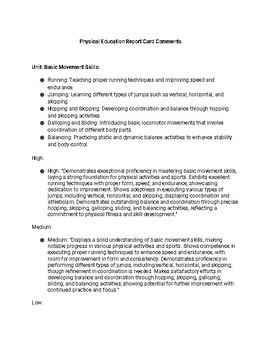Physical Education/Wellness Report Card Comments (editable)
Socratic Teacher
182 Followers
Grade Levels
Not Grade Specific
Subjects
Resource Type
Formats Included
- Word Document File
Pages
7 pages
Socratic Teacher
182 Followers
What educators are saying
I can't believe I am teaching gym this term. Thank you for saving my life with these. :) Highly recommend!!!
This is my first year teaching elementary gym and these comments are perfect for me and my class. I recommend these to other gym teachers for sure!
Description
Elementary physical education typically focuses on developing fundamental movement skills, promoting physical fitness, fostering teamwork and cooperation, and instilling healthy habits in children. The main categories for elementary physical education can be broken down as follows:
- Basic Movement Skills: These skills form the foundation for various physical activities and sports. They include:
- Running: Teaching proper running techniques and improving speed and endurance.
- Jumping: Learning different types of jumps such as vertical, horizontal, and skipping.
- Hopping and Skipping: Developing coordination and balance through hopping and skipping activities.
- Galloping and Sliding: Introducing basic locomotor movements that involve coordination of different body parts.
- Balancing: Practicing static and dynamic balance activities to enhance stability and body control.
- Physical Fitness: Elementary physical education aims to improve overall physical fitness through activities such as:
- Cardiovascular Endurance: Engaging in activities like jogging, dancing, or aerobic exercises to strengthen the heart and lungs.
- Muscular Strength: Performing exercises like push-ups, sit-ups, and squats to build muscular strength and endurance.
- Flexibility: Incorporating stretching exercises and yoga poses to improve flexibility and prevent injuries.
- Agility and Coordination: Playing games and participating in drills that enhance agility, hand-eye coordination, and spatial awareness.
- Sports and Games: Introducing children to a variety of sports and games helps them develop skills, sportsmanship, and teamwork. This category includes:
- Team Sports: Teaching the rules and basic skills of team sports such as soccer, basketball, volleyball, and handball.
- Individual Sports: Introducing activities like tennis, gymnastics, track and field events, and swimming.
- Cooperative Games: Organizing cooperative games and activities that emphasize teamwork, communication, and problem-solving skills.
- Health and Wellness: Educating children about the importance of leading a healthy lifestyle and making positive choices for their well-being. This includes:
- Nutrition Education: Teaching about the importance of balanced diets, making healthy food choices, and understanding food groups.
- Personal Hygiene: Promoting proper hygiene practices such as handwashing, dental care, and skincare.
- Mental and Emotional Health: Incorporating activities that encourage self-expression, stress management, and positive social interactions.
- Safety and Injury Prevention: Educating students about safety rules, first aid basics, and strategies for preventing common injuries during physical activities.
My report card comments are based on these categories and contain one high, medium and low comment for each unit/outcome.
Please see the preview!
Total Pages
7 pages
Answer Key
N/A
Teaching Duration
N/A
Last updated 4 months ago
Report this resource to TPT
Reported resources will be reviewed by our team. Report this resource to let us know if this resource violates TPT’s content guidelines.





